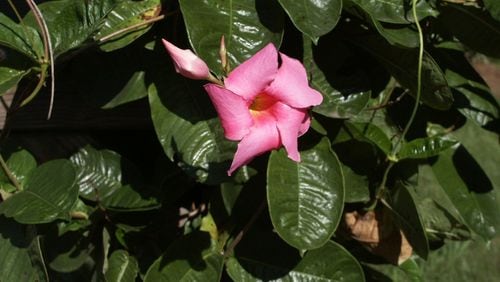Q: I have a beautiful 4-foot mandevilla in a big pot. I recently noticed several yellow leaves but I didn’t worry. However, today, about half of the plant turned yellow and brown and there’s a mold or fungus growing on the soil — and it stinks! Any tips? Debbie Green McAfee, Lawrenceville
A: The horrible smell comes from organic matter decomposing where there’s not much oxygen. Potted plants that are overwatered provide exactly this situation. Perhaps the drain hole became plugged. Excess water can’t escape. The families of microorganisms that naturally decompose potting soil change. Those that do best in well-drained soil change to those that do best in soggy environments. The first group has a pleasant smell; the soggy crowd emits gases that stink to high heaven. Root rot is usually present, too. Mandevilla is a tropical plant that’s used to daily showers but grows in soil that’s very well-drained. Your first job is to take the plant out of the pot and wash all the soil off the roots, if any. If you only see two or three scraggly roots with a gelatinous skin, your plant is fit only for compost. If you have several large white roots, you can replant the mandevilla in the pot using fresh potting soil. Put it in partial shade and wait a few months to see if it sprouts new growth. Consider yourself lucky if it does.
Q: I’ve had an Asian pear tree for six years. The first year I had it, it bore one of the sweetest Asian pears I’ve ever eaten. Ever since that, all I’ve ever gotten were these small brown fruits that never mature. The fruits are near the top branches. What am I doing wrong and how can I fix it? Bobbet Polk, email
A: It is common for fruit growers to graft a tasty, large pear variety to a vigorous root stock. In your case, it seems like an Asian pear was grafted to a wild Callery pear root stock. Over time, the Callery pear root stock sprouted a bud, which became a twig, which became a branch that grew so vigorously that it shaded out the Asian pear. I don’t know how much of the original pear tree is left, but your first job is to remove the big branch and determine if there is any life left in the first pear tree. If so, remove any dead limbs and wait for spring to manage any growth that appears.
Email Walter at georgiagardener@yahoo.com. Listen to his occasional garden comments on “Green and Growing with Ashley Frasca” Saturday mornings on 95.5 WSB. Visit his website, www.walterreeves.com, or join his Facebook page at bit.ly/georgiagardener for his latest tips.






